child seat GMC SAVANA 2003 Owner's Manual
[x] Cancel search | Manufacturer: GMC, Model Year: 2003, Model line: SAVANA, Model: GMC SAVANA 2003Pages: 392, PDF Size: 2.34 MB
Page 1 of 392

Seats and Restraint Systems........................... 1-1
Front Seats
............................................... 1-2
Rear Seats
............................................... 1-5
Safety Belts
.............................................. 1-9
Child Restraints
.......................................1-33
Air Bag System
.......................................1-63
Restraint System Check
............................1-75
Features and Controls..................................... 2-1
Keys
........................................................ 2-2
Doors and Locks
....................................... 2-8
Windows
.................................................2-16
Theft-Deterrent Systems
............................2-19
Starting and Operating Your Vehicle
...........2-20
Mirrors
....................................................2-32
OnStar
®System
......................................2-35
Storage Areas
.........................................2-36
Instrument Panel............................................. 3-1
Instrument Panel Overview
.......................... 3-2
Climate Controls
......................................3-17
Warning Lights, Gages and Indicators
.........3-23
Audio System(s)
.......................................3-41
Driving Your Vehicle....................................... 4-1
Your Driving, the Road, and Your Vehicle
..... 4-2
Towing
...................................................4-29Service and Appearance Care.......................... 5-1
Service
..................................................... 5-3
Fuel
......................................................... 5-4
Checking Things Under the Hood
................. 5-9
All-Wheel Drive
........................................5-46
Rear Axle
...............................................5-47
Front Axle
...............................................5-48
Noise Control System
...............................5-49
Bulb Replacement
....................................5-50
Windshield Wiper Blade Replacement
.........5-55
Tires
......................................................5-56
Appearance Care
.....................................5-82
Vehicle Identi�cation
.................................5-90
Electrical System
......................................5-91
Capacities and Speci�cations
.....................5-97
Normal Maintenance Replacement Parts
......5-100
Maintenance Schedule..................................... 6-1
Maintenance Schedule
................................ 6-2
Customer Assistance Information.................... 7-1
Customer Assistance Information
.................. 7-2
Reporting Safety Defects
............................ 7-9
Index.................................................................1
2003 GMC Savana Owner ManualM
2003 - Savana Owner Manual
Page 7 of 392

Front Seats......................................................1-2
Manual Seats................................................1-2
Power Seat...................................................1-3
Reclining Seatbacks........................................1-3
Rear Seats.......................................................1-5
Rear Seat Operation.......................................1-5
Safety Belts.....................................................1-9
Safety Belts: They Are for Everyone.................1-9
Questions and Answers About Safety Belts......1-13
How to Wear Safety Belts Properly.................1-14
Driver Position..............................................1-14
Safety Belt Use During Pregnancy..................1-22
Right Front Passenger Position.......................1-23
Center Passenger Position (2nd Row)..............1-23
Center Passenger Position (3rd, 4th and
5th Row) ..................................................1-24
Rear Seat Passengers..................................1-26
Rear Safety Belt Comfort Guides for
Children and Small Adults..........................1-29
Safety Belt Pretensioners...............................1-32
Safety Belt Extender.....................................1-32
Child Restraints.............................................1-33
Older Children..............................................1-33
Infants and Young Children............................1-36
Child Restraint Systems
.................................1-42
Where to Put the Restraint
.............................1-45
Top Strap
....................................................1-49Top Strap Anchor Location.............................1-50
Lower Anchorages and Top Tethers for
Children (LATCH System)...........................1-52
Securing a Child Restraint Designed for
the LATCH System....................................1-54
Securing a Child Restraint in a Rear
Outside Seat Position................................1-54
Securing a Child Restraint in a Center Seat
Position (2nd Row)....................................1-56
Securing a Child Restraint in a Center Seat
Position (3rd, 4th and 5th Row)...................1-57
Securing a Child Restraint in the Right
Front Seat Position....................................1-58
Air Bag System..............................................1-63
Where Are the Air Bags?...............................1-66
When Should an Air Bag Inflate?....................1-67
What Makes an Air Bag Inflate?.....................1-69
How Does an Air Bag Restrain?.....................1-69
What Will You See After an Air Bag Inflates?.......1-70
Air Bag Off Switch........................................1-71
Servicing Your Air Bag-Equipped Vehicle.........1-74
Adding Equipment to Your
Air Bag-Equipped Vehicle...........................1-75
Restraint System Check..................................1-75
Checking Your Restraint Systems...................1-75
Replacing Restraint System Parts
After a Crash............................................1-76
Section 1 Seats and Restraint Systems
1-1
2003 - Savana OM
Page 20 of 392

Q:If I’m a good driver, and I never drive far from
home, why should I wear safety belts?
A:You may be an excellent driver, but if you’re in an
accident–even one that isn’t your fault–you and
your passengers can be hurt. Being a good
driver doesn’t protect you from things beyond
your control, such as bad drivers.
Most accidents occur within 25 miles (40 km)
of home. And the greatest number of serious
injuries and deaths occur at speeds of less than
40 mph (65 km/h).
Safety belts are for everyone.
Howto Wear Safety Belts Properly
This part is only for people of adult size.
Be aware that there are special things to know about
safety belts and children. And there are different
rules for smaller children and babies. If a child will be
riding in your vehicle, seeOlder Children on page 1-33
orInfants and Young Children on page 1-36. Follow
those rules for everyone’s protection.
First, you’ll want to know which restraint systems your
vehicle has.
We’ll start with the driver position.
Driver Position
This part describes the driver’s restraint system.
Lap-Shoulder Belt
The driver has a lap-shoulder belt. Here’s how to
wear it properly.
1. Close and lock the door.
2. Adjust the seat so you can sit up straight.
To see how, see“Seats”in the Index.
1-14
2003 - Savana OM
Page 29 of 392

The best way to protect the fetus is to protect the
mother. When a safety belt is worn properly, it’s more
likely that the fetus won’t be hurt in a crash. For
pregnant women, as for anyone, the key to making
safety belts effective is wearing them properly.
Right Front Passenger Position
To learn how to wear the right front passenger’s safety
belt properly, seeDriver Position on page 1-14.
The right front passenger’s safety belt works the same
way as the driver’s safety belt—except for one
thing. If you ever pull the shoulder portion of the belt out
all the way, you will engage the child restraint locking
feature. If this happens, just let the belt go back all
the way and start again.
Center Passenger Position
(2nd Row)
If your vehicle has a second row bench seat, someone
can sit in the center position. When you sit in the
center position in the second row bench seat, you have
a lap-shoulder belt which works the same way as the
rear seat outside passengers’belts. To learn how
to wear a lap-shoulder belt see,“Lap-Shoulder Belt”
underRear Seat Passengers on page 1-26.
1-23
2003 - Savana OM
Page 35 of 392
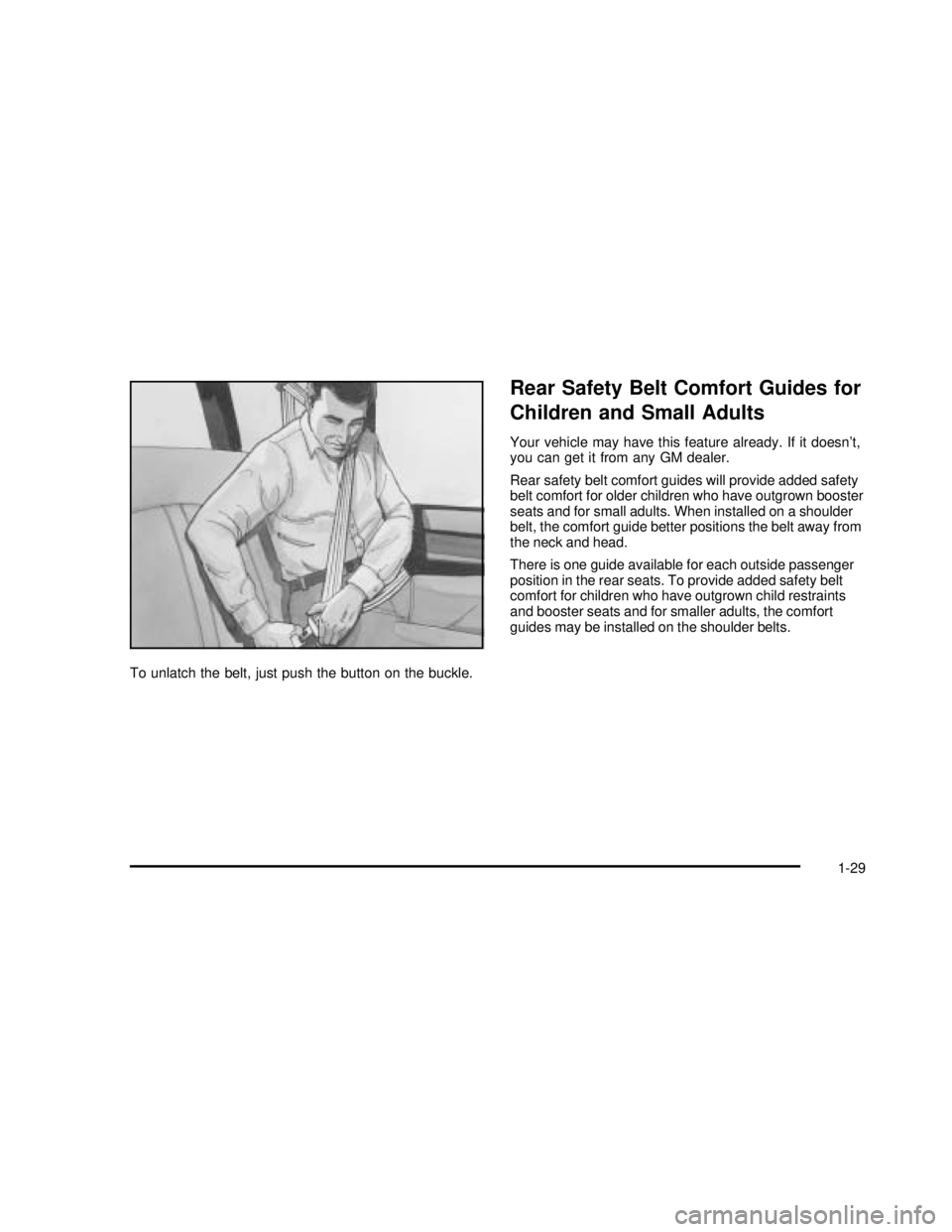
To unlatch the belt, just push the button on the buckle.
Rear Safety Belt Comfort Guides for
Children and Small Adults
Your vehicle may have this feature already. If it doesn’t,
you can get it from any GM dealer.
Rear safety belt comfort guides will provide added safety
belt comfort for older children who have outgrown booster
seats and for small adults. When installed on a shoulder
belt, the comfort guide better positions the belt away from
the neck and head.
There is one guide available for each outside passenger
position in the rear seats. To provide added safety belt
comfort for children who have outgrown child restraints
and booster seats and for smaller adults, the comfort
guides may be installed on the shoulder belts.
1-29
2003 - Savana OM
Page 39 of 392
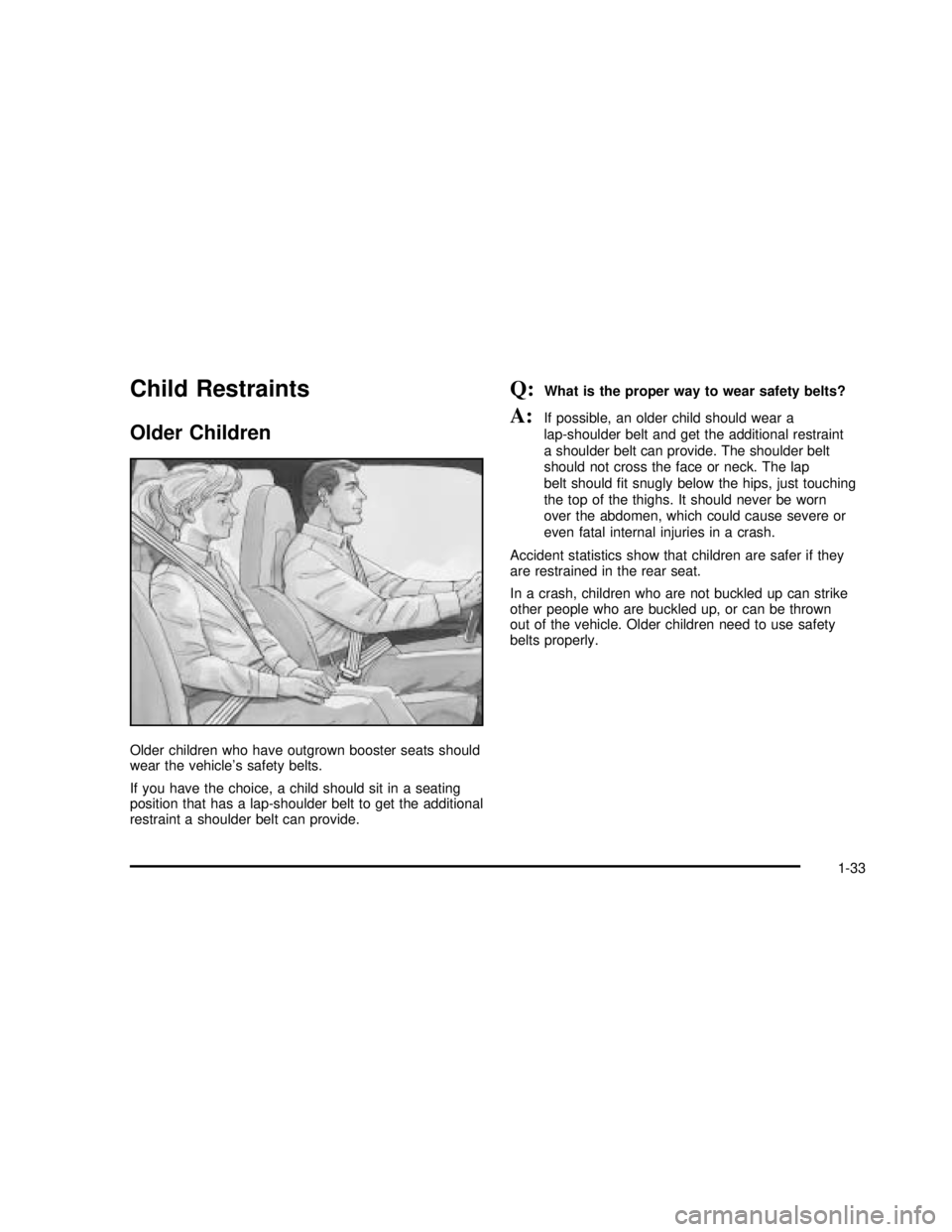
Child Restraints
Older Children
Older children who have outgrown booster seats should
wear the vehicle’s safety belts.
If you have the choice, a child should sit in a seating
position that has a lap-shoulder belt to get the additional
restraint a shoulder belt can provide.
Q:What is the proper way to wear safety belts?
A:If possible, an older child should wear a
lap-shoulder belt and get the additional restraint
a shoulder belt can provide. The shoulder belt
should not cross the face or neck. The lap
belt shouldfit snugly below the hips, just touching
the top of the thighs. It should never be worn
over the abdomen, which could cause severe or
even fatal internal injuries in a crash.
Accident statistics show that children are safer if they
are restrained in the rear seat.
In a crash, children who are not buckled up can strike
other people who are buckled up, or can be thrown
out of the vehicle. Older children need to use safety
belts properly.
1-33
2003 - Savana OM
Page 40 of 392
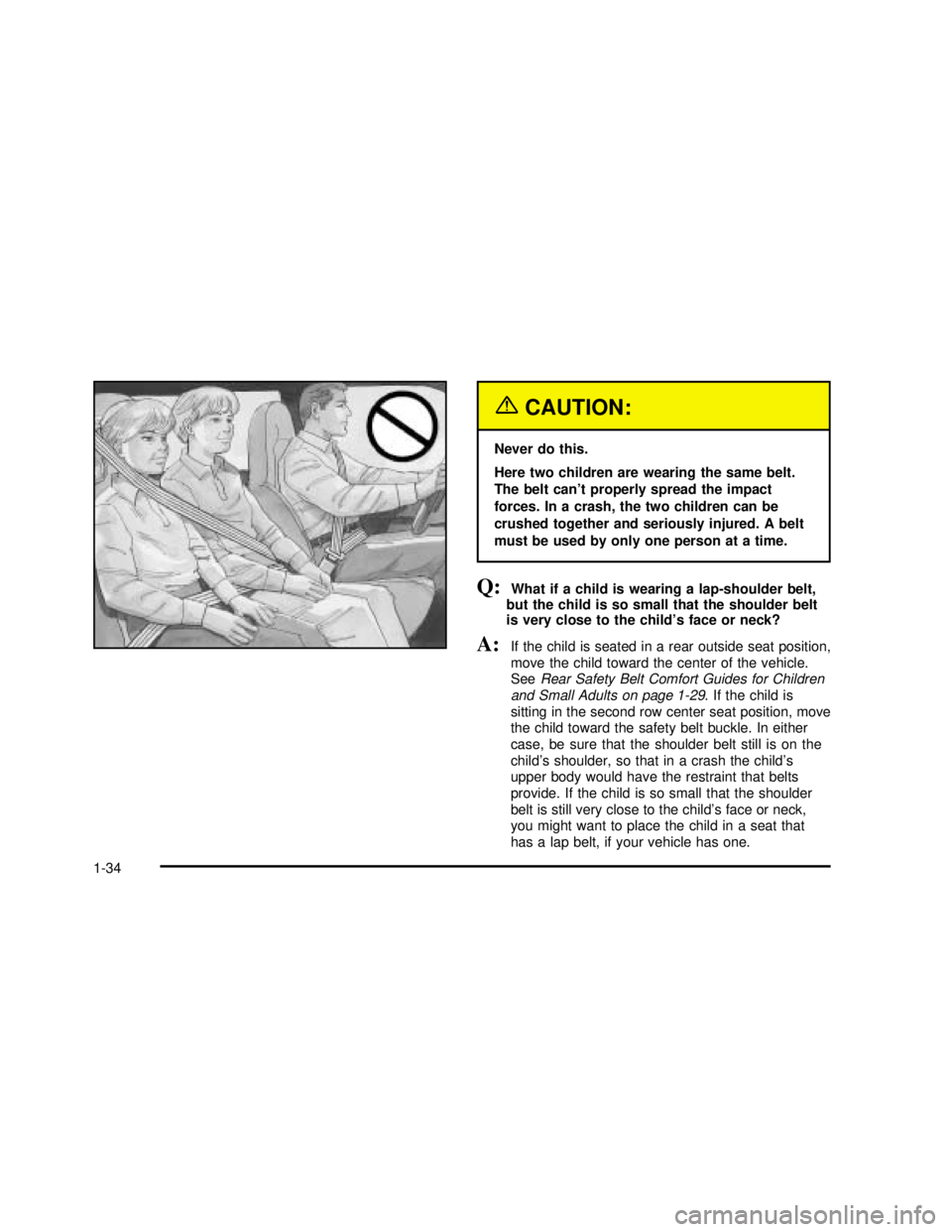
{CAUTION:
Never do this.
Here two children are wearing the same belt.
The belt can’t properly spread the impact
forces. In a crash, the two children can be
crushed together and seriously injured. A belt
must be used by only one person at a time.
Q:What if a child is wearing a lap-shoulder belt,
but the child is so small that the shoulder belt
is very close to the child’s face or neck?
A:If the child is seated in a rear outside seat position,
move the child toward the center of the vehicle.
SeeRear Safety Belt Comfort Guides for Children
and Small Adults on page 1-29. If the child is
sitting in the second row center seat position, move
the child toward the safety belt buckle. In either
case, be sure that the shoulder belt still is on the
child’s shoulder, so that in a crash the child’s
upper body would have the restraint that belts
provide. If the child is so small that the shoulder
belt is still very close to the child’s face or neck,
you might want to place the child in a seat that
has a lap belt, if your vehicle has one.
1-34
2003 - Savana OM
Page 41 of 392
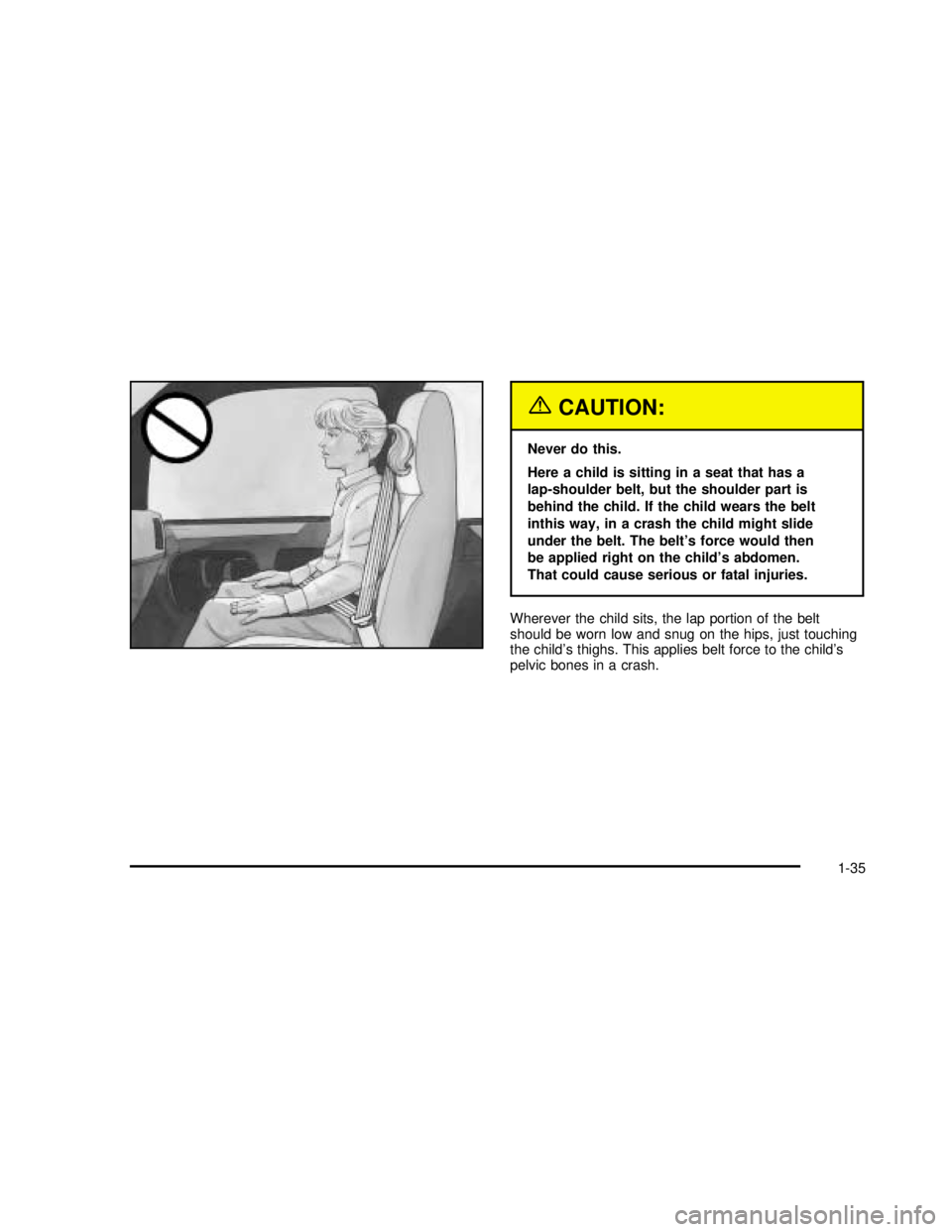
{CAUTION:
Never do this.
Here a child is sitting in a seat that has a
lap-shoulder belt, but the shoulder part is
behind the child. If the child wears the belt
inthis way, in a crash the child might slide
under the belt. The belt’s force would then
be applied right on the child’s abdomen.
That could cause serious or fatal injuries.
Wherever the child sits, the lap portion of the belt
should be worn low and snug on the hips, just touching
the child’s thighs. This applies belt force to the child’s
pelvic bones in a crash.
1-35
2003 - Savana OM
Page 44 of 392
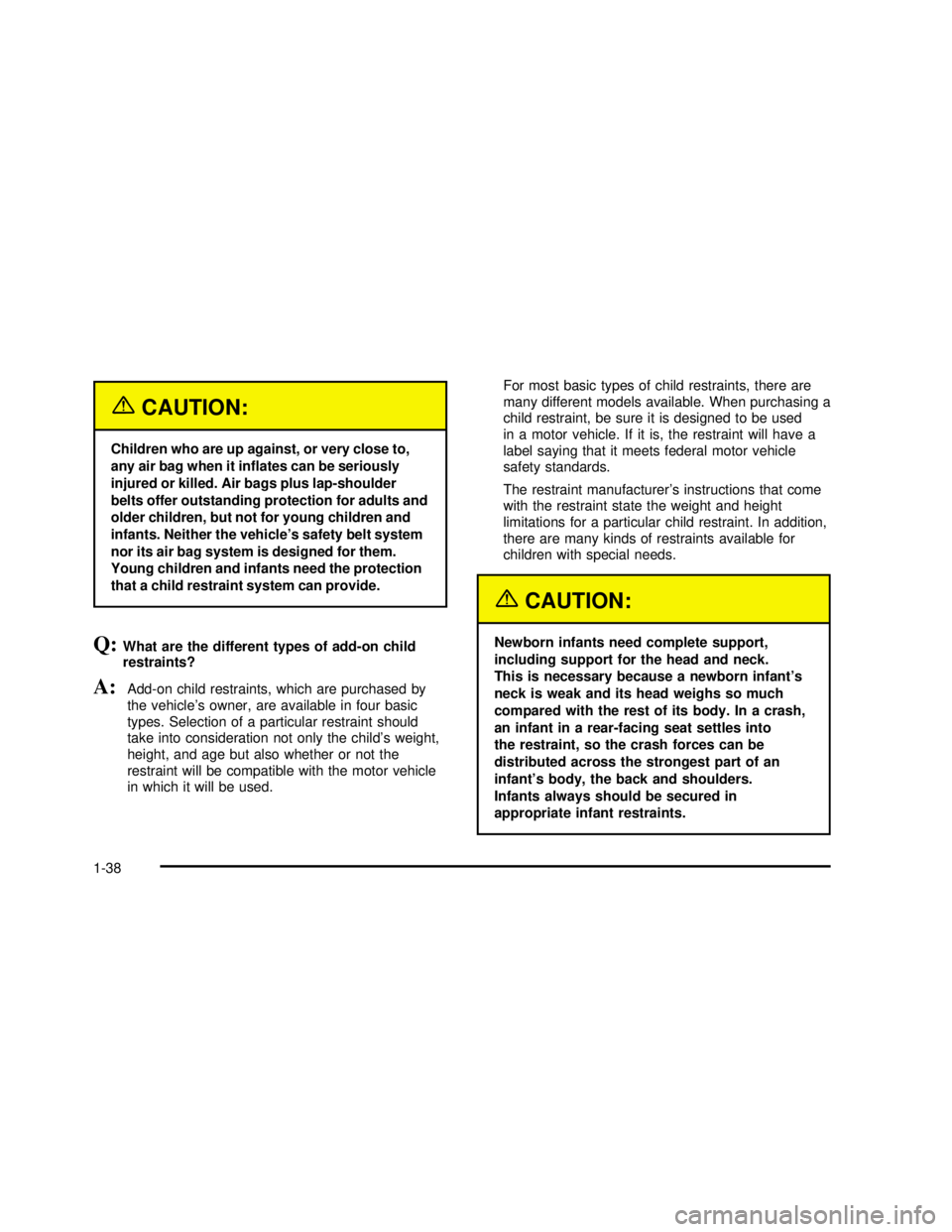
{CAUTION:
Children who are up against, or very close to,
any air bag when it inflates can be seriously
injured or killed. Air bags plus lap-shoulder
belts offer outstanding protection for adults and
older children, but not for young children and
infants. Neither the vehicle’s safety belt system
nor its air bag system is designed for them.
Young children and infants need the protection
that a child restraint system can provide.
Q:What are the different types of add-on child
restraints?
A:Add-on child restraints, which are purchased by
the vehicle’s owner, are available in four basic
types. Selection of a particular restraint should
take into consideration not only the child’s weight,
height, and age but also whether or not the
restraint will be compatible with the motor vehicle
in which it will be used.For most basic types of child restraints, there are
many different models available. When purchasing a
child restraint, be sure it is designed to be used
in a motor vehicle. If it is, the restraint will have a
label saying that it meets federal motor vehicle
safety standards.
The restraint manufacturer’s instructions that come
with the restraint state the weight and height
limitations for a particular child restraint. In addition,
there are many kinds of restraints available for
children with special needs.
{CAUTION:
Newborn infants need complete support,
including support for the head and neck.
This is necessary because a newborn infant’s
neck is weak and its head weighs so much
compared with the rest of its body. In a crash,
an infant in a rear-facing seat settles into
the restraint, so the crash forces can be
distributed across the strongest part of an
infant’s body, the back and shoulders.
Infants always should be secured in
appropriate infant restraints.
1-38
2003 - Savana OM
Page 46 of 392
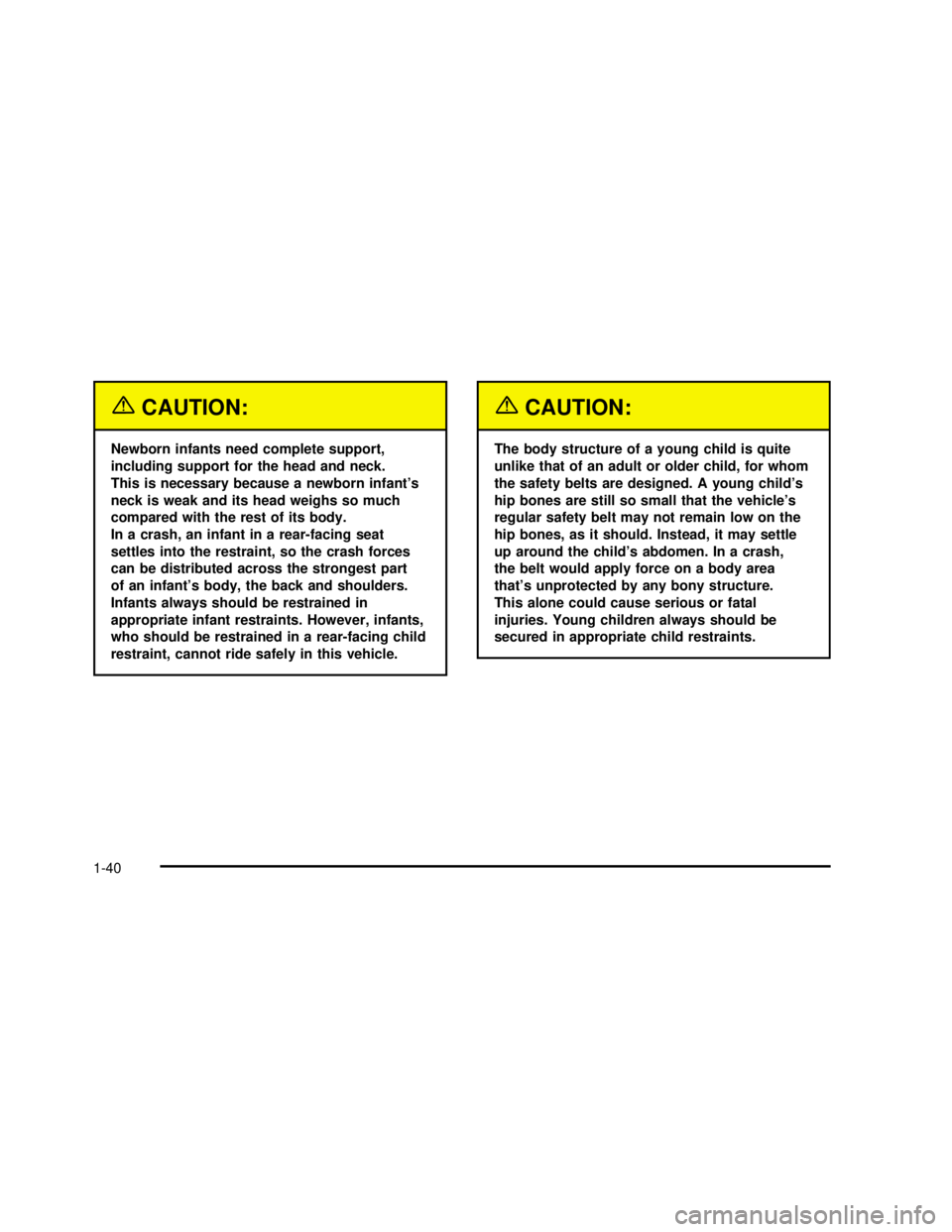
{CAUTION:
Newborn infants need complete support,
including support for the head and neck.
This is necessary because a newborn infant’s
neck is weak and its head weighs so much
compared with the rest of its body.
In a crash, an infant in a rear-facing seat
settles into the restraint, so the crash forces
can be distributed across the strongest part
of an infant’s body, the back and shoulders.
Infants always should be restrained in
appropriate infant restraints. However, infants,
who should be restrained in a rear-facing child
restraint, cannot ride safely in this vehicle.
{CAUTION:
The body structure of a young child is quite
unlike that of an adult or older child, for whom
the safety belts are designed. A young child’s
hip bones are still so small that the vehicle’s
regular safety belt may not remain lowon the
hip bones, as it should. Instead, it may settle
up around the child’s abdomen. In a crash,
the belt would apply force on a body area
that’s unprotected by any bony structure.
This alone could cause serious or fatal
injuries. Young children always should be
secured in appropriate child restraints.
1-40
2003 - Savana OM